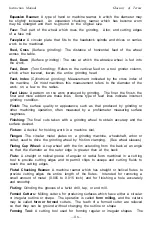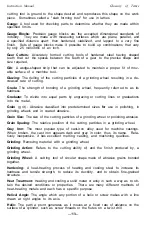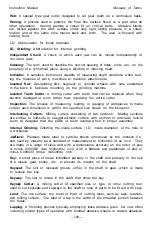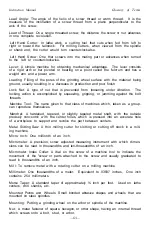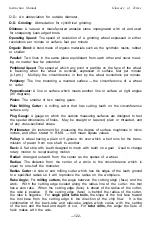
Instruction Manual Glossary of Terms
cutting tool is ground to the shape desired and reproduces this shape on the work
piece. Sometimes called a "slab forming tool" for use in lathes
Gauge:
A tool used for checking parts to determine whether they are made within
specified limits.
Gauge Blocks:
Precision gauge blocks are the accepted dimensional standards of
industry. They are made with measuring surfaces which are plane, parallel, and
a
specified distance apart; then hardened, stabilized, and lapped to a very fine
finish. Sets of gauge blocks make it possible to build up combinations that vary
by only 25 millionths of an inch.
Gear Cutters:
Accurately formed cutting tools of hardened steel having shaped
teeth that cut the spaces between the teeth of a gear to the precise shape and
size required.
Gib:
A wedge-shaped strip that can be adjusted to maintain a proper fit of mov
able surface of a machine tool.
Glazing:
The dulling of the cutting particles of a grinding wheel resulting in a de
creased rate of cutting.
Grade:
The strength of bonding of a grinding wheel, frequently referred to as its
hardness.
Graduate:
To divide into equal parts by engraving or cutting lines or graduations
into the metal.
Grain
(grit): Abrasive classified into predetermined sizes
for
use in polishing, in
grinding wheels and in coated abrasive.
Grain Size:
The size of the cutting particles of a grinding wheel or polishing abrasive
Grain Spacing:
The relative position of the cutting particles in
a
grinding wheel.
Gray Iron:
The most popular type of cast-iron alloy used for machine castings.
When broken, the cast iron appears dark and gray in color, thus its name. Rela
tively inexpensive, it has excellent melting, casting, and machining qualities.
Grinding:
Removing material with a grinding wheel.
Grinding Action:
Refers to the cutting ability of, and the finish produced by, a
grinding wheel.
Grinding Wheel:
A cutting tool of circular shape made of abrasive grains bonded
together.
Hardening:
A heat-treating process of heating and cooling steel to increase its
hardness and tensile strength, to reduce its ductility, and to obtain fine-grained
structure.
Heat Treatment:
Heating and cooling a solid metal or alloy in such a way as to ob
tain the desired conditions or properties. There are many different methods of
heat-treating metals and each has a specific purpose.
Helical Angle:
The angle which any portion of a helix or screw makes with a line
drawn at right angles to its axis.
Helix:
The path a point generates as it moves at a fixed rate of advance on the
surface of
a
cylinder, such as screw threads or the flutes on a twist drill
—119—














